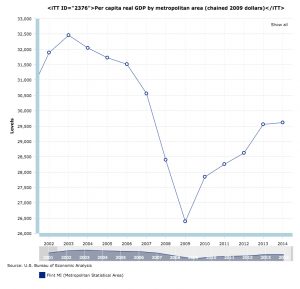One of the most important findings of environmental economics in recent decades is what is called the “environmental Kuznets curve”, a finding that as a community’s affluence rises, environmental “bads” – think air and water pollution, for example – decline. Could what has happened in Flint, Michigan, be evidence that this phenomenon is bi-directional – that as a community becomes impoverished, environmental conditions worsen?
In 1991 Princeton University economists Gene Grossman and Alan Krueger first documented this intriguing and potentially important relationship between wealth and pollution. At the time the United States, Mexico, and Canada were in the midst of negotiating what would become the North American Free Trade Agreement. NAFTA’s critics had objected that the deal would simply shift pollution from the more heavily regulated and affluent north to Mexico. Preparing for a conference on the deal, the pair looked at levels of sulfur dioxide and smoke pollution in 42 countries around the world. They found that as affluence grew in the 42 countries they studied, pollution grew along with it, but only to a point. Once per capita gross domestic product reached an inflection point ($4,000 to $5,000 in 1985 dollars), things turned around. It was as if, once people had their basic needs covered (food, housing, etc.) their desires turned toward a cleaner environment. The pollution curve, at least for sulfur dioxide and smoke, turned back down.
Could the expected income growth in Mexico, the pair wondered, push Mexico’s economy past the point at which the nation’s pollution curve bends back down? “A reduction in pollution may well be a side-benefit of increased Mexican specialization and trade,” they wrote.

Per capita GDP, Flint, Michigan, adjusted for inflation, courtesy BEA
The inverted U-shaped effect of environmental damage rising and then falling came to be called the “environmental Kuznets curve” after the work of economist Simon Kuznets, who in the 1950s posited a similar relationship between rising income and inequality. The observation resonated in a world in which rich countries seemed to have turned a corner on their pollution problems with things like the U.S. Clean Air and Clean Water acts and the Endangered Species Act, laws that reflected a culturally noticeable pivot in the decades before Grossman and Krueger published their pioneering work. In the years following the paper, a flurry of studies put empirical flesh on the skeleton, measuring the relationship across a range of environmental “bads”, from urban air pollution and deforestation to climate-changing emissions of carbon dioxide. Researchers argued about the statistical measures and the underlying theory, about whether income and wealth were the right causal variables, but again and again, their curves showed the inverted U’s of an EKC.
The story of Flint is well known – a community gutted by economic change, and left in the process with lead-contaminated drinking water. In terms of both total and per capita GDP, Flint’s economy tanked from 2004-2009, then began to recover in the years since. So is this a thing? As communities get poorer, do things like clean water fall by the wayside? Is Flint an example worth looking at, or does the curve above suggest that the timing is all wrong? How might we look more generally for a reverse EKC?

Flint’s economy, as Mae West might say, “had nothin’ to do with it.” At least in the Kuznetzian way. The decisions to take Flint off the Detroit water system, to use virtually untreated Flint River water instead, and to ignore and then hide clear signs that something serious was going wrong with Flint’s public health were not taken by people from impoverished Flint. The city was under state “emergency management” when each poor choice was made. Politics, not economics drove this.
Which may just mean that declining affluence attracts abuse and neglect, because, politically, it’s so easy to get away with.
Agree with Maresh. Flint folks did not make a decision to ignore water quality. This was a comedy of errors and incompetence by emergency managers, making decisions without good science.
Dave, Khal –
I agree with Dave’s characterization of the problem, but that doesn’t preclude a Kuznetzian explanation. One of the keys to the EKC phenomenon is the development of strong institutions as affluence grows. It is those institutions that are crucial for the implementation of the measures necessary to improve environmental conditions. Clear what happened in Flint involves the decay/failure of institutions, which seems related to the fact that the community was poor. In fact, if there is a reverse EKC (and I’m not sure there is, to be clear, or that Flint represents an example), then the decay of institutions is one possible mechanism.
How could it not be a side-effect of poverty and class? A marginalized population is living amidst a deteriorating infrastructure. There is no tax base to restore it, and even worse, the tax base is not adequate to maintain it. This sort of systemic failure will likely become the norm, rather than the exception, for as long as the federal government remains in the “austerity trap” the conservatives have given us.
Actually the issue is that the folks in Flint could not pay the water bills needed to replace the lead pipes, just like in many cities. Lots of water piping is approaching 100 years old. Consider that Flints population was 38k in 1910, 96k in 1920, 156k in 1930 peaking at 196k in 1960. In 2010 its population was down to 102k and estimated at 99k in 2014, so it soon will be back to the population of 1920. So clearly most housing was likley built in the 1920s and is approaching 100 years old.
In most cities the water system is a self supported system, so that upgrades are paid for in the water rates. Flint due to population decrease may also have the same problem cited in western cities of lower water demand resulting in less money coming in all be it for a different reason.